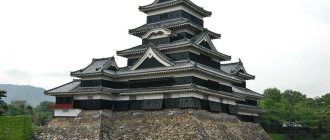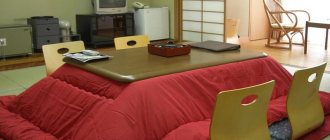Interior design in the Japanese style is suitable for those people who can feel the aesthetics and picturesqueness of the space around them through simple and light configurations, natural and unpretentious colors, for those who do not need to be surrounded by luxury decorative items and furniture, for those who are characterized by love to convenience and order. If a person has the ability to see beauty in small things, if he wants to feel harmony with the surrounding space and his thoughts, if he feels a great connection with nature, then the Japanese interior style will come in handy more than ever.
This style is not flashy, but there is a lot of exoticism in it, very unusual for the Russian average person, but at the same time multifunctional and modern. This style seeks balance in everything, strives for comfort without frills and for the use of natural materials, adheres to the accepted rules of ergonomics of room objects. Japanese style is not only the appearance of a room, it is an integral philosophical teaching, with the help of which you can get to know yourself through decorative elements and surrounding things, become closer to nature, and organize your thoughts and outlook on life.
History of the style
The distant 16-17 centuries are the time of the emergence of the main principles of the Japanese style. At that time, changes began to occur in the way of life of the population in all aspects of state policy. The process of stratification of the population began - the middle class was steadily gaining weight, the wealthy class began to stand out noticeably, and the emergence of scientific and technological progress influenced the formation of the main motives in the interior of Japanese homes.
But even the fact that the country took the path of development of capitalism, the power was centralized and there were people with great income who could create the elite interior of their apartments according to the latest fashion, taking a guide to general trends, the Japanese did not change themselves. The consciousness of the inhabitants of the Land of the Rising Sun was oriented, like that of their ancestors, on the consonance of nature and the beauty of the universe, allowing all classes to look for beauty in ordinary objects, without furnishing themselves with precious interior objects.
The history, geography and climate of the country itself had a significant impact on the formation of Japanese stylistics. Since the country's territory is located in an earthquake-prone zone, this forced the Japanese to invent all kinds of methods for preserving and reusing housing during earthquakes. The walls, ceilings and even the foundations of Japanese houses were prefabricated; they could be dismantled during the raging of the elements, and after it - or moved to another place and rebuilt in the same place. Partitions and internal walls were completely absent, this is explained not only by the fear of the elements, but also by the desire of the Japanese to turn even a small house into a spacious home.
Free planning of living space is one of the characteristic qualities of the design of Japanese buildings, which was formed due to the fact that, having a high population density and small areas, it was necessary to use all the space to the maximum level. After all, very often two or three generations of a family could live in one house. This influenced the lack of a huge number of interior details and strong colorization of textiles and other decorative elements.
Standard rooms in a Japanese house were not clearly separated by functionality, but the combined rooms had clear functional areas. Such zones were distinguished by the arrangement of light elements, multi-level ceilings and floors, and light partitions made of bamboo material.
If we summarize the factors that influenced the synthesis of traditional Japanese style in the design of premises, we get the following:
- territory of the country - islands where the population is densely populated;
- natural disasters – frequent earthquakes;
- lack of abundant minerals such as iron ore;
- national traditions, ideas and philosophies that have historically influenced the way of life of the Japanese.
Of course, now Japanese style has undergone a lot of changes compared to the 16th century, dictated by time. However, even the advent of concrete, metal and other innovative materials that imitate natural raw materials did not change the desire for a natural interior and the use of real wood or stone when decorating premises.
A blanket with the smell of the sun in a house made of wood and paper.
Every year more people sleep on a bed, but according to a 2013 Nifty survey, at least half of Japanese sleep the old-fashioned way, with a futon mattress laid out directly on top of a tatami mat. During the daytime, the futon is rolled up and placed on a special shelf in the closet, thus freeing up additional space in the room. From time to time, the futon is dried directly in the sun for the purpose of disinfection and also to prevent the mattress from becoming damp. If you keep your futon clean, it will remain soft and comfortable for a very long time. Only in winter it’s cold in a Japanese room. You have to put a yutampo heating pad in the futon, use a heater or kotatsu, warm up in the o-furo and after that dive into a warm futon.
All ready for bed: traditional Japanese futon mattress
Nowadays, if you choose to stay overnight in a hotel or ryokan in a renovated traditional house, as is now fashionable, then in this “old” new space, created using natural materials, you can finally take a little break from your usual everyday life, and your trip it will turn out unforgettable. Be sure to try to get to know this unique world, created with the help of craftsmanship that has come down to this day from ancient times. Enjoy the world of wood and paper, a world of calm and tranquility.
Banner photo: A cat naps on a sunny engawa veranda.
Minka (literally "people's house(s)") is a traditional Japanese house.
In the context of the division of Japanese society into classes, minka were the dwellings of Japanese peasants, artisans and merchants, i.e. non-samurai part of the population. But since then, the class division of society has disappeared, so the word “minka” can be used to refer to any traditional Japanese houses of the appropriate age.
Minks have a wide range of styles and sizes, which is largely due to geographical and climatic conditions, as well as the lifestyle of the inhabitants of the house. But in principle, minka can be divided into two types: village houses (noka; nōka) and city houses (machiya; machiya) . In the case of village houses, a subclass of fishermen's houses can also be distinguished, which are called gyoka.
In general, surviving minkas are considered historical monuments, and many are protected by local municipalities or the national government. Of particular note are the so-called gasshō-zukuri , which survive in two villages in central Japan - Shirakawa (Gifu Prefecture) and Gokayama (Toyama Prefecture). Collectively, these buildings have been listed as a UNESCO World Heritage Site. The peculiarity of these houses is their roofs, which meet at an angle of 60 degrees, like hands folded in prayer. Actually, this is reflected in their name - “gassho-zukuri” can be translated as “folded hands”.
The central principle in the construction of the mink was the use of cheap and accessible building materials. The peasants could not afford to import something very expensive or use something that was difficult to find in their home village. So, almost all nokas are made exclusively from wood, bamboo, clay and various types of grass and straw.
The “skeleton” of the house, roofs, walls and supports are made of wood. fusuma screens were used instead .
Grasses and straw were also used to make roofing, mushiro mats and tatami mats. Sometimes the roof, in addition to thatch, was covered with baked clay tiles. Stone was often used to create or strengthen the foundation of a house, but stone was never used in the construction of the house itself.
As in other forms of traditional Japanese architecture, wooden supports supported the bulk of the structure, so that "windows" could be created in any part of the house. The supports formed the "skeleton" of the house, connecting to the cross beams in an ingenious structure without the use of nails, and the "holes" in the walls of the house were made using shoji and heavier wooden doors.
Gassho-zukuri are perhaps the most recognizable Japanese houses, and also the tallest - due to their outstanding roofs in every sense. High roofs made it possible to do without a chimney and arrange extensive storage areas, and also, first of all, to protect the house from moisture. Thanks to the design of the roof, snow or rain immediately rolled down without stopping, making the roof practically “waterproof”, and the straw covering it almost did not rot.
There are three main roof styles, which share a number of similarities with the roofs of other styles of Japanese architecture. Most machiya have gable, gabled "kirizuma" roofs , covered with roofing shingles or tiles. In contrast, most noka were either thatched (yosemune) and had roofs sloping on four sides, or their roofs were made with multiple gables and covered with shingles and thatch (irimoya).
Special caps were installed at the roof ridge and at the junctions of various sections. The tiles or shingles that covered the roofs often served as the only artistic decoration of the houses, plus the roof ridges were decorated with ornaments.
The interior decoration of a mink was usually divided into two sections. In the first of them, an earthen floor was left, this area was called “home” (doma), and in the second, the floor was raised 50 cm above the level of the house and covered with tatami or musiro . The house was used for cooking and other agricultural needs. As a rule, it contained a kamado clay stove , a wooden washbasin, barrels for food and jugs for water.
A large wooden ōdo door served as the main entrance to the building. A built-in irori hearth was often built into the raised floor , but no chimney was built to connect the hearth to the outside environment. Only sometimes a small ventilation window was made in the roof. The smoke went up, under the roof, so that the residents did not breathe it or soot, but nevertheless the smoke stained the straw, which had to be changed often.
A Japanese house is such an original structure that it is difficult to say who influenced whom: either the inhabitant of this home expressed his life philosophy through it, or, on the contrary, the house formed the peculiar habits of those who live in it.
A Japanese house is a canopy, and a canopy over an empty space . This is primarily a roof supported by a frame of wooden rafters and supports. There are no walls or doors in our understanding, because in each room three of the four walls can be moved apart at any time, or even removed altogether. When such sliding doors, easily removed from the grooves, serve as external walls, that is, they act as windows, they are covered with white rice paper, similar to tissue paper, and are called shoji.
When you first see the inside of a Japanese home , what strikes you most is the complete absence of any furniture. All you see is the exposed wood of the support posts and rafters, the ceiling of planed boards, the latticework of shoji , the rice paper of which softly diffuses the light coming from outside. Under your bare feet, the tatami springs slightly—hard, three-finger-thick mats made of quilted straw mats . The floor, made up of these golden rectangles, is completely empty. The walls are also empty. There are no decorations anywhere, except for a niche where a scroll with a painting or a calligraphed poem hangs, and under it there is a vase of flowers: ikebana.
Japanese style motifs
The current Japanese style in interior design is distinguished by exoticism, originality and originality, and it is formed on the basis of the following principles when decorating premises:
- The concept of this stylist consists of the desire to know oneself through rapprochement with nature. The ideal design option was private houses, in which Japanese motifs from inside the room smoothly and easily move outside, merging with nature and the landscapes of the local area. If it comes to decorating apartments, then there is a way out - to grow dwarf bonsai trees or bamboo, even to decorate a small greenhouse on the territory of a loggia or balcony.
- The main priority when implementing this style is the use of natural materials and decorative items. However, in modern society the use of artificial substitutes for wood or stone is not uncommon. And here it is important that the quality of such materials is of the highest level. The use of natural raw materials - stones, straw, wood, bamboo and rapeseed - makes it possible to create a truly original interior, imbued with the Asian spirit.
- Considering the color scheme of Japanese homes and buildings, we can highlight the main color - light, flesh-colored types of wood. Additional shades in the interior were golden, sandy, light brown and all pastel colors. Black is the most popular color for zoning an area or creating contrast. The brightest and most meaningful interior objects were often highlighted with a black or graphite background.
- Furniture in such design projects always has an optimal and ideal geometric shape, is made with clear and strict lines, and has low legs, backs, and armrests, tending downward. This name allows you to create an authentic Japanese interior.
- The less decor, decorations and interior elements, the more free space in the living space. This is a fundamental factor in Japanese style.
- Functional areas are highlighted using screens woven from straw or bamboo partitions. To separate rooms, doors or shutters with a sliding mechanism are mainly used.
Modern housing in Japan
The average size of a house/apartment in Japan is 5 rooms. There are three bedrooms, a living room and a kitchen/dining room. The living area of such a house is about 90 square meters. m. For private houses, this is, respectively, 6 rooms and about 120 sq. m. m of living space. In Tokyo, where housing prices are significantly higher, apartments and houses are on average one room smaller.
The vast majority of Japanese children have their own room (for each child).
Modern Japanese homes almost always have at least one traditional-style room . The remaining rooms are usually made in European style, with wooden floors, carpets, beds, tables, chairs and so on.
In modern Japanese houses it is cold to walk in tabi (the floor is not heated), so the Japanese wear slippers. There are special slippers for the toilet to avoid spreading dirt. In general, the Japanese are very scrupulous about personal and home hygiene.
It is not customary to wash in Japanese baths and saunas. They are designed to relax in hot water after a hard day. It is customary to get into the bathroom and go to the bathhouse only after first washing in the shower. Usually in the evenings the whole family takes a bath, and in the same water - it is very expensive in Japan. Usually the water in the bath is heated to 40°.
In general, Japanese housing is worse and more expensive than in most European countries and America. Many modern Japanese houses are reminiscent of Khrushchev's five-story buildings in design and quality of construction, and in terms of amenities they may even be worse.
About 60% of Japanese people live in their own homes. The rest either rent housing or live in houses provided to them by the company they work for or the government. There are, of course, homeless people, but not that many.
Most private houses are located in the suburbs of large cities or in rural areas. To get to work, the Japanese take trains.
The main means of transportation in big cities is Japanese public transport (subway and buses). However, two out of every three Japanese have a driver's license and own a car. You can get a license to drive a motorcycle from the age of 16, and a license to drive a car from the age of 18. Between cities, the Japanese prefer to travel by rail, the high-speed train system - Shinkansen .
Materials in the interior of Asian style
In order to repeat all the traditions of the Japanese style, to express all its originality, one should use the materials that were used in those distant times when the style began to develop. Such raw materials include the following:
- wood material (species - maple, kiri, cedar);
- natural stone (tiles were made from it);
- straw from grain crops, bamboo, reed;
- rattan, wicker, matting fabric;
- silk and leather materials.
In modern interiors, artificial materials are often used. After all, it is very difficult to give up plastic, acrylic, and linoleum. However, when using a substitute for natural materials, you should choose only high-quality analogues, for example, replace wood with a high-quality laminate, replace natural silk fabric with artificial silk, only one that even a professional cannot distinguish. Only with this approach to choosing analogues of natural raw materials will it be possible to preserve all the flavor of the Japanese style.
Basic principles
When creating a modern Japanese style in an apartment, you need to remember the basic principles.
- Do not overuse interior items and decorative accessories.
- A minimum of furniture is one of the main rules of modern Japanese style.
- The finishing is made from natural materials without the use of plastic or artificial fabrics.
- It is preferable to decorate rooms in light colors.
- No more than three basic colors should be used indoors.
Interior furniture with Asian melodies
The Japanese always strive to understand themselves and the world around them; their life activity boils down to a “striving for the earth” - they love to sit and contemplate. This is also reflected in the furniture of Japanese houses; it looks as if its legs were cut off and everything unnecessary was removed. The furniture also reflects one of the main principles of Japanese style - the less, the better. The interior contains only the most necessary furniture elements.
Furniture in a Japanese house, according to traditions and foundations, can consist of:
- tables for the most important Japanese ceremony - tea drinking, which have low legs;
- very often ordinary mattresses or tatami are used as beds;
- sliding wardrobes are used to store various things;
- Kitchen furniture is almost always closed - all accessories are stored in cabinets and cabinets.
A modern interior in this style can be filled with furniture in two ways:
- Find furniture with Asian influences in antique stores and auctions, which have a long history.
- Choose modern furniture from Asian-themed collections from manufacturers.
Living room interior
The Japanese living room interior also deserves attention. Comfort and coziness should reign in this room; it should be light, bright and spacious. Preference should be given to miniature furniture, and high cabinets and bulky sofas should be abandoned. The fewer furnishings there are, the better.
The walls, floor and ceiling should ideally be plain and not attract attention. Dominant tones are white, light brown, beige. It would be great if the shades of the furniture were a little deeper. As decoration, you can choose paintings that depict hieroglyphs or sakura, a bonsai plant. A samurai sword will be a wonderful decoration for the walls.
Partitions and their features
Partitions in Japanese homes are made of a wooden frame, which is lined with rice paper or straw; they are called “shoji”. Thanks to them, the authenticity of the room is formed, and zones are clearly demarcated by function. Traditional houses were equipped with lightweight and simple partitions because they could be easily and cheaply replaced in the event of an earthquake. Nowadays, such partitions are often replaced by ordinary, lightweight sliding sections, on which a wicker pattern is applied.
In the past, the main purpose of the “shoji” was to create a secluded corner in the common area of the home. A man from a large family needed his own meters for reflection and self-knowledge. Now tea areas and areas for reading books are fenced off with partitions.
Decorative elements
What can you tell us about decorative Japanese interior items? They must also serve the main goal, which is to achieve harmony and balance. The decorative elements are:
- engravings, paintings;
- Buddha figurines;
- Samurai sword;
- ikebana;
- screen made of silk or rice paper;
- decorative vases;
- china;
- tea ceremony set;
- Japanese lanterns;
- bonsai trees.
A fan is a traditional decorative element that should not be forgotten. This thing symbolizes the fullness of life and well-being in its open form. It is believed that it protects the home from negative energy. Doll figures in colorful national costumes, which can be compared to a work of art, will also help create the atmosphere. These products are not intended for children's play. They are needed to admire their grace and fragility.
Flooring
Almost everywhere, the strongest and heaviest types of wood were used for flooring. If the room was in a high humidity area, then pebbles or stone tiles were placed. Now you can use parquet or high-quality laminate, matte ceramics. To create originality and immerse yourself in Japan's past, you can line the floor with special carpets made from wicker or reeds.
The floor is very often used as a tool for zoning space and is performed at different levels. The tea table, now often used as coffee tables, is literally recessed into the floor, and if necessary, can be easily removed and performs its direct function.
Textiles are an important material
To create a comfortable atmosphere in the interior, natural fabrics in non-flashy natural shades are used. Plain cotton, linen, silk fabrics and their mixtures with hieroglyphs and Asian images take us to Japan with its traditions and flavor.
Fabric material can also be used in the design of screens, tea areas or for draping windows. In most cases, windows are decorated with plain Japanese curtains - smooth, dense rectangular screens made of fabric. It is possible to apply Asian-themed ornaments and hieroglyphs to these screens. Nowadays, roller blinds or blinds are often used on windows.
Kitchen interier
If the kitchen has a small area, the Japanese style will be a real salvation. Furniture should be functional and simple. Products made from unpainted wood will fit organically into such an interior. The dominant shades are caramel, baked milk, bleached oak. Accents can be placed using green, light green, and red tones.
Household appliances must be hidden, for which closed compact cabinets are used. In the dining area you can place a low table with a soft sofa. Alternatively, offer a simple dining table and chairs adorned with cushions. The walls are decorated with stylized engravings and hieroglyphs.
You should not fill your window sills with indoor plants. It is preferable to use flowers in floor vases. The window can be decorated with panel curtains made of cotton or linen. They let in enough light.
Style accents in the interior
To create a Japanese style in the interior, you cannot do without harmony. So, using bright, accentuating elements, it is necessary to find a balance to create a balanced interior that is designed to relax a person. In ancient times, it was impossible to find rich, bright walls or furniture in Japanese homes. Yes, the Japanese had and still have a love for the bright red color, but they skillfully dosed it in the design of their homes.
The overall neutral and light picture of the interior was most often highlighted by the following accents:
- vases and other tableware made of painted porcelain;
- growing bamboo and bonsai trees;
- porcelain classic tea ceremony sets;
- fabric paintings - panels with Asian motifs;
- for illumination - lampshades made of paper (rice or rapeseed).
Ideas
It is easier to decorate one relatively large room in Japanese style - in a country house or in a spacious apartment. But such a design task can be quite successfully solved in a small apartment. You don’t have to completely part with your usual furniture, and if you can’t make repairs, you can only get by with thoughtful decoration.
If you want to give a Japanese flavor to your living room, bedroom or nursery, first of all, imagine the color scheme of the wallpaper and draperies. A combination of neutral-colored, plain walls with expressively decorated curtains, bedspreads, and sofa cushions looks harmonious. Conversely, if you choose bright wallpaper with Japanese motifs, then neither the upholstery nor the curtains should distract attention. It is better if they are in calm tones.
The combination of a neutral background and bright details is also important for the kitchen interior. Let wonderful dishes stand in a prominent place in the kitchen: dishes and plates of special shapes, a set for a tea ceremony. It’s easy to purchase paper and cloth napkins decorated in Japanese style, and use traditional tenugui . Let everything form a harmonious ensemble: curtains and lantern-shaped lamps, decoration on the wall above the dining table - a painting or engraving, a flower arrangement or a magnificent fan. Even the refrigerator door can be decorated with a decorative element.
A Japanese-style hallway is the place where the brightest and most colorful wallpaper will look best. They can depict landscapes, plants, mythological animals and birds, and people in traditional clothes. Complement the interior with lantern lamps that match the color, one or two decorative elements - and your hallway will be transformed.
Wardrobes and interior doors can play a special role in creating the spirit of Japan. Their rectangular shape is ideally styled to resemble traditional shoji partitions. In many cases, decorative elements, paintings or engravings, and individual hieroglyphs can be placed here. This is especially convenient when you are creating the interior of a children's room.
It’s great if you and your child can choose wallpaper, curtains, and accessories. It is very convenient if you have a light, colorfully painted screen, with which you can quickly fence off part of the room.
Interesting and unusual objects will develop children's curiosity, and works of art will develop artistic taste. Perhaps your child will become seriously interested in Japanese culture, and it all starts with calligraphic hieroglyphs, origami works, or just a wonderful doll in a kimono!
In addition to paintings and calligraphic scrolls, ceramic vases, netsuke figurines, origami figures, beautifully painted fans and other art objects are used to decorate interiors. A bonsai tree or flower arrangement is often placed in a prominent place.
Dolls look great in traditional clothes. Your guests will certainly be interested in a beautiful geisha or a courageous samurai.
Most accessories can be placed on shelves or mounted on the wall. However, it is important that there are not too many of them. And then your interior will always remain harmonious.
Room lighting
Japanese houses were equipped with light sources that emitted only diffuse light. It made it possible to create an atmosphere that relaxes and encourages a person to create. This was achieved with the same paper lampshades. Ceiling lighting was typically used to create emphasis on a specific functional area
Light served an important function in delineating the space of an open plan. Now this aspect is also used when creating interior design projects. It is the correct lighting system in such an interior that sets originality and tradition, and is also the final touch to the interior.
Summing up
Nowadays, Japanese-style interiors are very popular, as they allow one to achieve the perfect harmony of modernity and authenticity. Japanese style is a bright representative of minimalism. Its various elements can add accents to even the most boring interior, which can then hardly be called trivial. In an Asian interior, you can realize all your thoughts and fantasies, which will bring harmony and comfort to any home.









